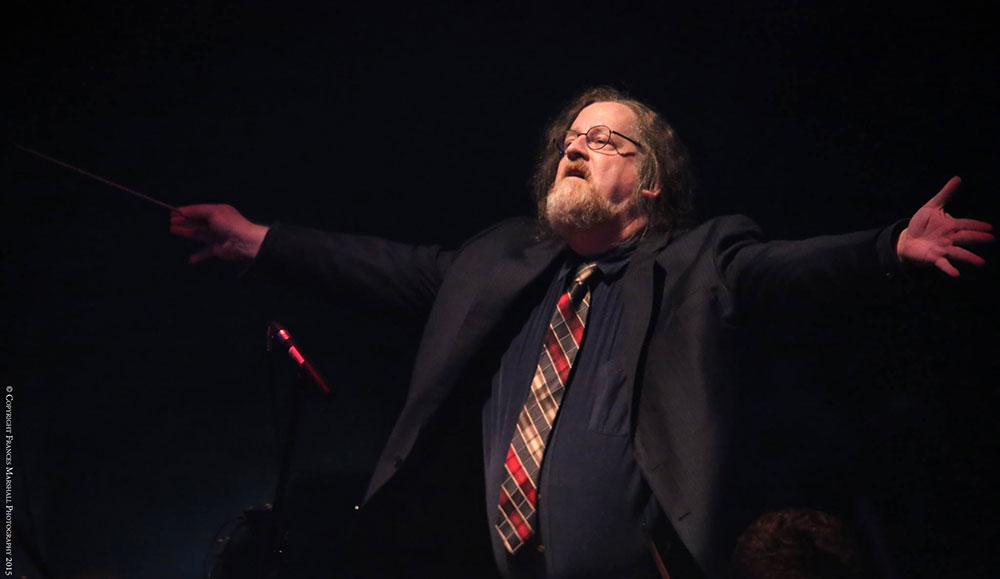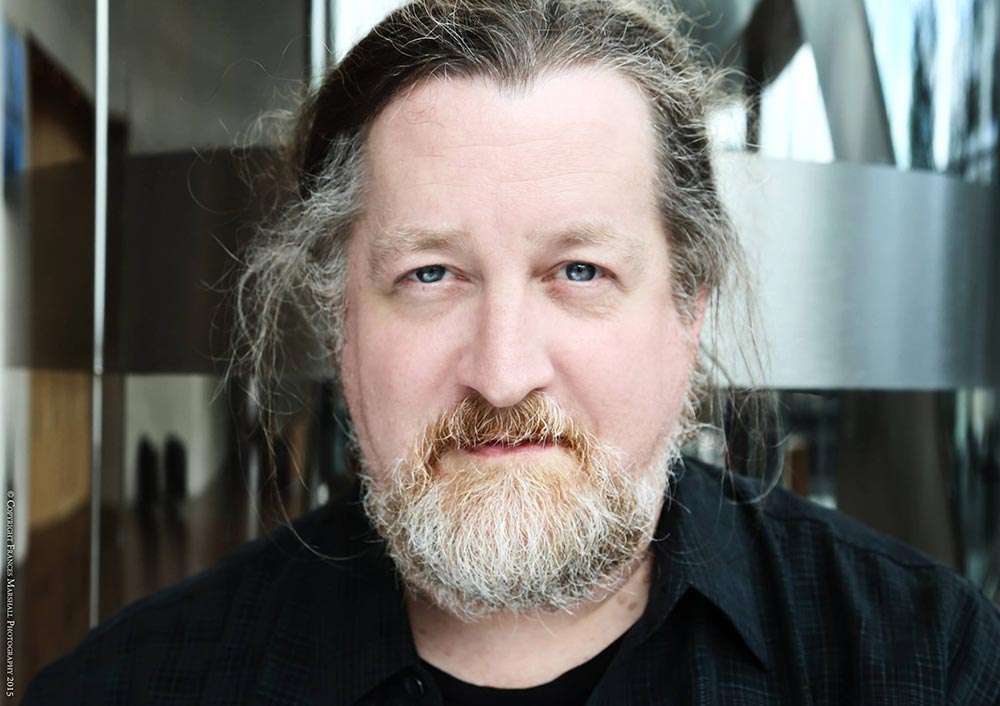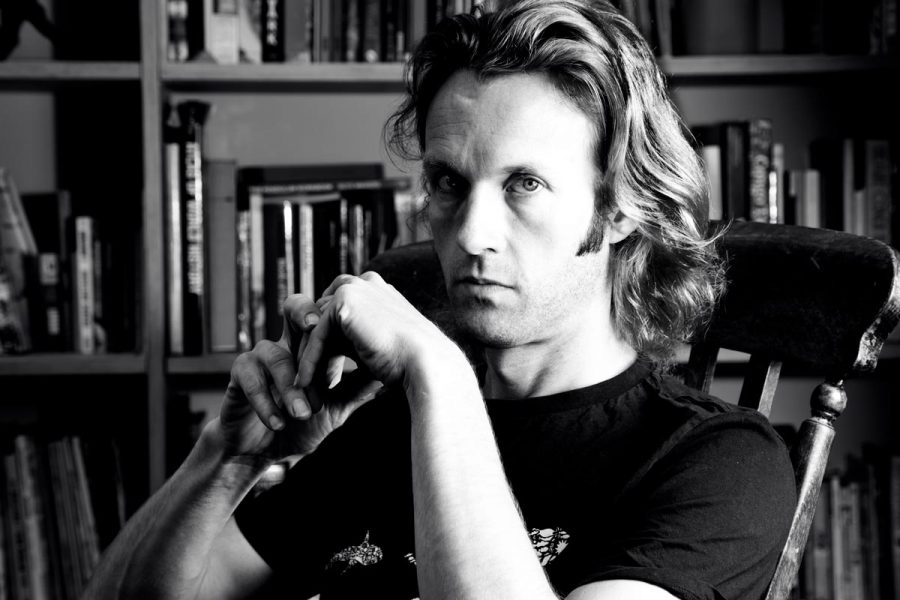The Art of Video Game Music: Russell Brower

December 2015
Words by
Emer Nestor
Photos by
Frances Marshall
American composer Russell Brower is a three-time Emmy Award winner and Senior Director of Audio at Blizzard Entertainment. He is especially known for his contributions to the development of the World of Warcraft, Diablo III, StarCraft II, Heroes of the Storm and Hearthstone franchises. Previously, Brower served as a Principal Media Designer and Music Director at Walt Disney Imagineering — creators of Disney’s theme parks worldwide.
As an independent composer and sound artist, he has worked on a variety of projects, specials and films including Animaniacs, Batman (the Animated Series) and Tiny Toon Adventures. He serves on the Boards of Directors of the Society of Composers & Lyricists and the Game Audio Network Guild, and is a member of NATAS and NARAS. Brower is also an instructor for the UCLA Extension Program. In 2014, ‘Invincible’ from World of Warcraft: Wrath of the Lich King, made its first appearance in the Classic FM Hall of Fame Top 300 at No. 52.
In his interview with Final Note Brower discusses his time as a Disney Imagineer, his work in an array of globally successful animated TV series, composing for video games, and the influence of classical music on his writing process.
Every night of my young life he sent me off to dreamland with piped-in classical music, film scores, vintage radio dramas — all the music and entertainment he loved."

Tell us about your early introduction to the world of music.
My father was an avid “audiophile” and he had our family home wired for sound long before it was fashionable. Every night of my young life he sent me off to dreamland with piped-in classical music, film scores, vintage radio dramas — all the music and entertainment he loved. Upon reflection, I now realize that his influence is 100% the reason why I love music, and specifically the reason why I love music which tells a story.
Where did you learn your craft?
I am mostly self-taught. However, I did first join a choir in elementary school under the direction of Ms Susan Schuck, where I learned the joy of being part of a larger musical group. My dear aunt did attempt some piano lessons with me when I was 6 or 7 years old, but I wasn’t the best student. I have come to realize that I needed to find my musical “voice” and love first, and apply the theory after that. I think my brain is just wired this way, as most formal musical education I encountered required theory and technique to be mastered before self-expression and composition were considered. Now that I have context for my musical ideas, I absolutely adore theory and study everything I can as an adult.
I would like to also give a shout out to my high school choir teacher, Mr Glenn DeLange. He taught me and my fellow choristers true musicality: interpretation, nuance, blend, tone color, the beauty of expression in both dynamics and time…everything. When I conduct especially, I can see his every move and channel all I have learned.
I spent several years working on projects, which put me alongside composer/songwriter George Wilkins in various supporting/production roles. I learned more by watching him than I could ever have in school. He was always generous with his wisdom and even gave me my first big composing break for Disney in 1985.
I also want to express my appreciation for the mentoring I received from the late, great, Shirley Walker (Batman the Animated Series) and Buddy Baker (Disney theme parks).
Does classical music influence your musical process?
Absolutely. Starting with my father’s record collection, I became enamoured with music that painted clear pictures in my mind, and/or caused a stirring of my emotions. Debussy, Ravel, Grieg, Grofé, Copland, Stravinsky and their ilk were my greatest influences. I borrowed miniature scores from the library and followed along, learning to read music in the process.
Later on, Bernard Herrmann, Miklos Rozsa, Erich Korngold, Morton Gould and John Williams became important influences, along with Disney’s Frank Churchill, Leigh Harline and George Bruns — all from the film and theme park genres.
What motivated your desire to become a Disney Imagineer?
Growing up in Disneyland’s backyard, relatively speaking, I became fascinated early by the creation of a world from our imaginations, which you could actually go visit, explore and experience in three-dimensions. After briefly wanting to be a Disney animator, I decided at the age of 9 to help design and build “real-life” adventures and attractions.
The tie-in with music came when I first visited ‘The Haunted Mansion’ attraction the week after it first opened: from the opening strains of eerie pipe organ music in the old Victorian house, I was hooked. In a subsequent scene, I noticed that the howling, stormy, wind that was apparently battering the structure was actually playing that same haunting melody heard earlier. The power of music, combined with technical know-how and showmanship, had just hit me like a ton of bricks and cemented my love of communicating story and emotion via music and other synchronized media.
A fun bit of life and career symmetry occurred over 20 years later, when ‘Haunted Mansion’ composer Buddy Baker explained to me how he achieved that musical effect, along with veteran Disney sound artist Jimmy Macdonald — also one of my heroes.




In many cases, theme parks can be the potential epitome of immersion. The guest is "on stage" and "part of the show", to borrow the Disney parlance."

You created an array of successful sound environments for many Disney theme parks and attractions — what elements do you take into consideration when designing music/sound for this medium?
In many cases, theme parks can be the potential epitome of immersion. The guest is “on stage” and “part of the show”, to borrow the Disney parlance. Sound comes from a combination of live sources, such as the huffing of a steam locomotive, and pre-recorded tracks, rendered from speakers hidden all around. The mix of all these elements is a product of where the guest is standing or moving at any moment in time, which means that the sonic environment is extremely dynamic, challenging to control and nearly impossible to predict.
Imagineers embrace such challenges and I recall the joy of deftly hiding a speaker in a facade or landscape, and later walking (or riding) the route, setting volume level and other parameters after helping craft the very sound emitted from the speaker. In some cases, speakers were treated much like lighting, in that creative use of indirect sound, or “bouncing” the waves off neighboring surfaces offered a diffuse effect, reducing the guest’s ability to discern location.
The planning, creation and production of the soundtracks themselves proved similar to video games: combining standard music and sound recording techniques with computerized, situational triggers to start, stop and manipulate the finished tracks in real time, based on what the guests (or players) are doing.
What was it like to work on the music of such hugely successful animated TV shows as Tiny Toon Adventures, Animaniacs, and Batman — what did you take from this experience?
These shows were the very pinnacle of a long television animation career for me, and seeing as how I grew up watching Bugs Bunny and Road Runner cartoons, it was a great personal thrill.
Mostly, I worked on these shows as the music and sound effects dubbing mixer, and sound supervisor. The most important take-away was my experience working with Shirley Walker on Batman; we spotted every frame of every episode together (a task the other composers were not so inclined to do), and we crafted the sonic approach to all the action as a team. She also shared with me countless insights into her musical decision-making, went over finished scores with me, and consulted together on the final mix of all the sound elements at the end. Because of this process, the Batman shows mixed quickly and sublimely; music and sound enhanced, rather than competed with each other. I have never forgotten the lessons she taught me.
Eventually, the musical director of Animaniacs, Richard Stone, with a little prodding from series producer/creator Tom Ruegger, gave me the opportunity to score several segments of the show, for which I am forever grateful.
How did you segue into the world of video game music?
Thirteen years of my early career were as a freelancer and I picked up sound and music work anywhere I could. Video games were a regular part of my cycle of projects from the very beginning, including my first job at Walt Disney Imagineering, where I worked on an “arcade of the future”, which had been destined for the new EPCOT Center project.
Two decades later, when I found myself needing to reinvent and diversify from television and theme parks, I phoned up an early client, Novalogic, and asked if they needed any music or sound. Timing is important, and in this case I hit it right; Novalogic replied and told me that their Audio Director had just moved on. I was offered the job full-time.
After two rewarding years there, I left to seek projects that were a bit more “up my alley” (I felt I would prefer high fantasy over military simulation games), and found my way to Blizzard Entertainment as their new Audio Director in 2005.



Is there a difference between the role of music in film and TV, to that of video games?
At the heart of things, the roles are not much different, since storytelling and communication are art forms which can transcend genres and mediums. Musical storytelling reaches people via pure emotional pathways and evokes often complex responses without regard to language barriers or limitations; these traits are no less true in games than they are for film, television or the concert hall.
If a composer can effectively communicate his or her mental and emotional “images” via music, the differences between the various mediums become almost purely technical. In games, the music will often be sliced into subsets of itself, temporally and/or by orchestration-defined layers: Intro/Verse/Chorus/Outro; Rhythm Layer/Chordal or “pad” Layer/Melodic Layer…just to name a few. Such subsets of the music can be triggered or altered in volume under real-time computer control to support gameplay.
While the technical aspects noted above can and will partially inform the composition process, I am of the opinion that the most effective music is approached first as a traditional “plussing of the story” challenge, with the desired technical aspects considered second. Otherwise, it becomes far too easy for the score to become formulaic or derivative.
In terms of musical aesthetics, what draws you into the fantastical worlds of animation and gaming?
From earliest childhood, I was drawn to music which moved me and stimulated vivid mental imagery. Grofé’s Grand Canyon Suite is one of the first scores I studied on my own; I was fascinated with how he could create the sounds of thunderstorm with an orchestra, following its progression from a quiet desert, thick with the smell of impending rain, to the gathering of thunderheads, the initial drops of rain, and all the way into the tempest and through to its aftermath. Games invite similar aural interpretations of both scene and mood. I hope that listeners to our soundtrack albums find themselves taken on a similar journey.
In 2014 your piece, ‘Invincible’, from the score for World of Warcraft: Wrath of the Lich King, made its first appearance in the Classic FM Hall of Fame Top 300 — how does the classical world react to your work?
I was absolutely floored when I found out about this tremendous honor! Indeed, I had to pinch myself when I realized that the music I had created had made this list alongside works which I consider timeless. It’s almost too much to get my head around.
As for how the classical world reacts, I can only report that I have been indescribably touched by the respect and encouragement I have received from musicians when I have had the honor to take the podium to conduct a score that I wrote. Often, the players simply express that they did not realize video game music had progressed beyond “bleeps and bloops” — and when a seasoned symphony musician tells me that they enjoyed playing my piece and could just float home — I figure these people have seen it all, and so their sincerely kind words buoy my spirits for days after.
I also think that it is terribly important that families and children re-discover the symphony together — and I see video game music being a great catalyst for this. I love nothing more than to have a parent come up to me after a concert and tell me that their daughter or son has decided to learn an instrument after attending a video game music concert.
What are your thoughts on the value of classical music within the games industry?
This emerging art of video game music composition would be nothing without classical music. It is within the works of Debussy, Ravel, Mussorgsky, Stravinsky, Saint-Saëns, Mozart, Beethoven and countless others that we have found the influence of the subtlety of emotion, the power of bombast, the contrast of tears and joy, sound and silence — all of which have inspired composers like myself to create music that shall hopefully prove to heighten the experience of a game, and make it more personal and timeless for the player.
When I was very young, I listened to the soundtrack of Disney’s Fantasia (under the command of Stokowski) and wept as Mussorgsky’s Night On Bald Mountain transitioned into Schubert’s Ave Maria — it was that transition itself (the stark contrast between the profane and the sacred, bridged by simple notes) which knocked out all my defenses, took my breath away, and made me want to somehow be involved in the creation of something similarly powerful…and timeless…someday!
Do you have any desire to compose contemporary concert music?
Absolutely. I especially enjoy writing or arranging for specific instruments and the musicians who play them. Given my (proudly intentional) old-school leanings, I imagine concert music from me will not necessarily sound all that contemporary. However, I don’t consider this a bad thing. Just as Blizzard Entertainment makes the games its developers want to play, I will keep writing the music I want to hear, regardless of what genre or period it appears to fall within.
Tell us about your recent involvement in the iDIG music festival in Dublin.
I was proud to lend my support and enthusiasm to Eímear Noone and Craig Stuart Garfinkle’s festival earlier this year. In addition to hearing all the wonderful, authentic Irish musical interpretations of game scores, I did a Q&A session with attendees and participated in the Video Games Live concert as a guest conductor. Eímear conducts Blizzard’s big orchestral sessions and she’s my conducting teacher, so we’re all close friends. She and I share a love of music which comes from the same place in our respective hearts, and the only thing we love more is sharing that excitement with others. I’m proud of their accomplishment in bringing iDIG into being, and I can’t wait for the next one.
Describe an average day in your life as Senior Director of Audio at Blizzard Entertainment.
The best days include writing music, and those days begin quite early, maybe 4 or 4:30am. With a good night’s sleep beforehand, I am usually fairly productive for several hours at my piano, with pencil and paper (no computers at this stage). I write until I am finished with a task, or about noon. The rest of the day is spent tending to department-wide administrative tasks, “casting” of composers for different projects, and many other things. Blizzard works on many projects at once these days, so most of what I do is in service to the overall company, or in the endeavour to keep our sound department a safe and inspiring place in which creative people can work and thrive. The one hands-on musical task I retain is overall musical direction for World of Warcraft; to date, I’ve written about half the music in the game and provided oversight on most of the total 62 hours of original music currently in the game.
Are you working on any composition projects at the moment?
In addition to World of Warcraft, I am writing music for a “solo” album, which will feature full orchestra and choir in a style that shall hopefully feel familiar to those who know my music. I am dedicating it, both in terms of inspiration and commemoration, to the memory of my dear mother, who was always my most important fan. It is a labour of love, and a Kickstarter campaign to enlist the support of all the listeners without whom I’d have no career, and to whom I’m eternally grateful, will begin in Spring 2016. I am excited to express my gratitude in the best way that I can: with some epic and emotional music to whisk people away on a journey for a little while.
All images displayed in this article are subject to copyright.
Share this article





